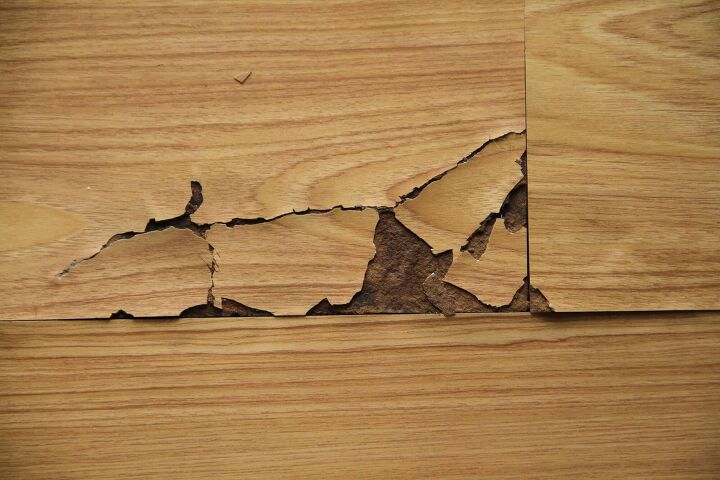How To Fix A Laminate Floor That Got Wet

Laminate flooring is stunning and designed to have a long lifespan, but it cannot stand up to water. Whether your sink sprung a leak, or you were a victim of a flood, when your laminate floor gets wet, it can become ruined quickly.
Although a small water spill on laminate flooring is unlikely to cause damage if cleaned up immediately, larger spills that sit long enough can penetrate beneath the seams and cause major damage. In many cases, you may even have to replace the whole floor. But if the damage is not too extensive, you can fix the issue yourself. As long as you catch it early, you may be able to fix it without too much trouble.
If the floor is showing any signs of damage, you will likely have to pull up the floorboards that are damaged and replace them. We’ll walk you through all the steps you need to take to get your laminate flooring looking good as new again, without any signs of water damage.
Do You Need Wood or Stone Flooring Repair?
Get free, zero-commitment quotes from pro contractors near you.

Water Spills on Laminate Flooring
When you spill water on laminate flooring, damage will only occur if the surface has become saturated. Once the spill happens, you want to act quickly and pat it dry using a towel or sponge. With larger spills or flooding on laminate flooring, the surface becomes saturated with water and damage happens as a result of the water seeping between the seams.
Although the wear layer of laminate flooring is designed to protect against spills, when water reaches the gaps in the floorboard, the fiberboard core gets wet and causes swelling. When enough water gets into the seams, the core absorbs all the moisture and can show a number of signs of water damage. Some of the most common signs of damage to your laminate floor include:
- Discoloration
- Visible mold
- Swelling
- Excessive cupping
- Cracking
- Buckling
- Splitting
- Bubbling
Unfortunately, once the floor boards get wet, they cannot be easily fixed. Even if the surface of your laminate appears dry, the surface can still hold enough water to cause bubbling at the seams. If caught early enough, you may be able to remove the affected planks, allow them to dry, and then reinstall.
However, if you notice any of the above signs, you are likely going to need to replace some of the floor boards. But, there are steps to take to make sure it is done correctly.
Step One: Make Sure the Leak is Fixed
If your floor was damaged by a leaky pipe or faucet, make sure you fix that before even starting on the floor. If you have been in a flood, be sure that the danger is over and follow safety precautions because there may be dangerous pollutants in the water.
Step Two: Check for Damage in Adjacent Areas
Go through the entire room and look for signs of water damage on the entire floor. Mark the damaged areas with a marker or tape so you know what areas need to be replaced. Evaluate the floors in the rooms adjacent to the damaged room as well since the water could have spread easily.
Step Three: Grab the Tools You Will Need
Always make sure you have everything you need before you start any job. Even if it is just a simple job. A quick fix can turn into a long project if you have to stop in the middle and go to the hardware store. Some of the items you will need for this job include:
- Replacement boards and underlaying material
- Cleaning solvent
- Hammer
- Pliers
- Utility knife
- Measuring tape
- Floor adhesive
- Putty knife
- Safety glasses
Step Four: Removing the Damaged Boards
After determining where the damage is and gathering all your tools and parts, it’s time to remove the damaged boards and material. Pull the boards up carefully using the putty knife. Check the floor underneath for mold. Clean it with solvent before moving on to the next step.
Step Five: Replacing the Damaged Floorboards
Replacement is the most time-consuming part of the job. That is because you have to make sure the boards match the ones already on your floor. But you should have already done that when you got your tools and parts ready. Apply the adhesive to the floor and place a heavy object on the spot until it dries. This will probably take a few hours, but it is best to give it a full 24 hours just to be sure.
Why You Cannot Just Use Heat to Fix the Damage
Some floor materials can be fixed by using a hairdryer or heater. However, laminate flooring has fibers that absorb water quickly. This makes the floor swell along the edges. The hairdryer or heater may come in handy to dry the floor underneath, but it will not save the boards that are already damaged.
When to Seek Professional Help
Undeniably, fixing laminate flooring that has experienced water damage can be a time-consuming and labor-intensive endeavor. If you don’t know how to do it properly, you could actually cause more damage to your flooring.
If you feel insecure about your abilities, consider seeking the help of a professional to handle the repairs. They will address the root of the problem and replace the floorboards, as needed, professionally.
Additionally, if you see mold either on your laminate flooring or under the floorboards, you will likely need to talk to a professional. It only takes between 24 and 48 hours for mold to start growing under wet floorboards. Because mold can be dangerous and hard to get rid of completely, it is best to let the experts take care of the problem for you.
If the Damage Goes Too Deep
If the damage goes through the laminate and underlay, you should check the subfloor for water damage. If you do see water damage to the subfloor, you will need a licensed professional to fix it. This is a dangerous situation that can cause the floor to give way, so it is important to get someone to fix it right away.
How Does Water Damage Laminate?
Water that has been left on the flooring too long will soak into the layers underneath the floorboards and cause them to rot or fall apart. A typical laminate floor has four sections:
Wear Layer
On top of all of the other layers, the laminate is covered in layers of clear resin to protect it. There may be three to five layers, depending on the manufacturer. This protects the boards from everyday wear and tear as well as scratches and damage. It is also a temporary moisture barrier, but only for the laminate floorboards, not when the moisture gets in between the boards.
Image or Design Layer
Obviously, the image or design layer is the pattern on your floorboards. It is essentially just an image printed onto a thin layer of resin that is glued to the base layer.
Core or Base Layer
The core or base layer is under the design layer and on top of the backing layer. This is the main part of the floorboard and it is typically made of a wood material called high-density fiberboard.
Backing Layer
At the very bottom of your laminate floorboard is the part that touches the actual floorboards of your home. The backing layer is a moisture preventer as well as a way to balance the board on the floorboards.
Drying Floorboards In a Pinch
If the damage is not bad or if you just cannot find the right color or style to match your existing floor, you may be able to dry the boards. Take the wet boards out and use dehumidifiers and fans to dry them. It may take hours, or it could take days. It depends on how wet they are and how humid your home is.
While you are waiting for these boards to dry, clean, and disinfect the boards under your laminate flooring to prepare for reinstalling them. If you suspect that there was enough water in the subfloor to possibly cause mold, use a bleach solution and a dry towel to clean the wet areas. Let everything dry for several days.
Do You Need Wood or Stone Flooring Repair?
Get free, zero-commitment quotes from pro contractors near you.

Wrapping Things Up
While laminate flooring is supposed to be water-resistant, it is not waterproof. If you spill something on your floor, clean it up quickly. That type of spill is no big deal as long as you clean it up right away, so it does not get underneath the floorboard. If you have major damage from a leak or other home issue that has been fixed, your floor will be fine as long as you replace the damaged boards.
However, if you had flooding, you may want to consider a different type of flooring. Especially if you are in a flood-prone area or flood plain. A new type of vinyl called wood plastic composite (WPC) with a waterproof core is supposed to be waterproof. It comes in many colors and patterns, including wood planks. You may want to look into it if you plan to stay in a home that is in a flood plain.

I am a DIYer who loves writing about anything home-related. When I am not writing, you can find me studying for my PhD in Psychology, photographing nature, and swimming at the lake with my grandkids.
More by Patricia Oelze













![How Much Weight Can a 4×4 Support Horizontally? [It Depends!]](https://cdn-fastly.upgradedhome.com/media/2023/07/31/9070333/how-much-weight-can-a-44-support-horizontally-it-depends.jpg?size=350x220)














